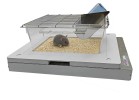Authors
A. Charlet, J.-L. Rodeau, P. Poisbeau.
Lab
Centre National de la Recherche Scientifique, Institut des Neurosciences Cellulaires et Intégratives,Nociception and Pain Department, Strasbourg, France.
Journal
The Journal of Pain
Abstract
Effective relief of acute and long-term postoperative pain is of utmost importance to patients undergoing surgery. Here, we worked on a controlled procedure of abdominal surgery in the rat inducing persistent postoperative pain symptoms for up to 10 days and tested the efficacy of perioperative care with the local anesthetic ropivacaine. Laparotomy was likewise used to implant radiotelemetric probes by which electrocardiogram, body temperature, and locomotor activity were recorded in freely moving animals. We showed that postoperative pain symptoms (mechanical allodynia) measured in periphery of the scar were associated over time with persistent tachycardia, elevated heart rate variability, and loss of mobility. Furthermore, a single subcutaneous infiltration of the local anesthetic ropivacaine in the periphery of the abdominal incision was sufficient to prevent the appearance of allodynia and the associated cardiac and motor signs of pain, monitored by radiotelemetry. These beneficial effects were observed when the infiltration was performed in the perioperative period, but not later. This study on freely moving animals exhibiting long-lasting postoperative pain symptoms and altered autonomic/motor function illustrates well the importance of the timing of preemptive analgesia care with long-acting local anesthetics. Moreover, it emphasizes the utility of monitoring heart rate variability to quantify spontaneous expression of long-lasting postoperative pain. PERSPECTIVE: Speeding the recovery time after surgery using perioperative ropivacaine care is of significant clinical relevance because it might limit the risk of chronic pain and postoperative complications. In humans, chronobiological analysis of heart rate variability could also help quantify spontaneous pain expression with minimal emotional bias.
BIOSEB Instruments Used:
Activmeter (BIO-ACTIV-R)

 Pain - Thermal Allodynia / Hyperalgesia
Pain - Thermal Allodynia / Hyperalgesia Pain - Spontaneous Pain - Postural Deficit
Pain - Spontaneous Pain - Postural Deficit Pain - Mechanical Allodynia / Hyperalgesia
Pain - Mechanical Allodynia / Hyperalgesia Learning/Memory - Attention - Addiction
Learning/Memory - Attention - Addiction Physiology & Respiratory Research
Physiology & Respiratory Research
 Pain
Pain Central Nervous System (CNS)
Central Nervous System (CNS) Neurodegeneration
Neurodegeneration Sensory system
Sensory system Motor control
Motor control Mood Disorders
Mood Disorders Other disorders
Other disorders Muscular system
Muscular system Joints
Joints Metabolism
Metabolism Cross-disciplinary subjects
Cross-disciplinary subjects Preclinical studies and opioids: role in crisis management in the United States
Preclinical studies and opioids: role in crisis management in the United States 